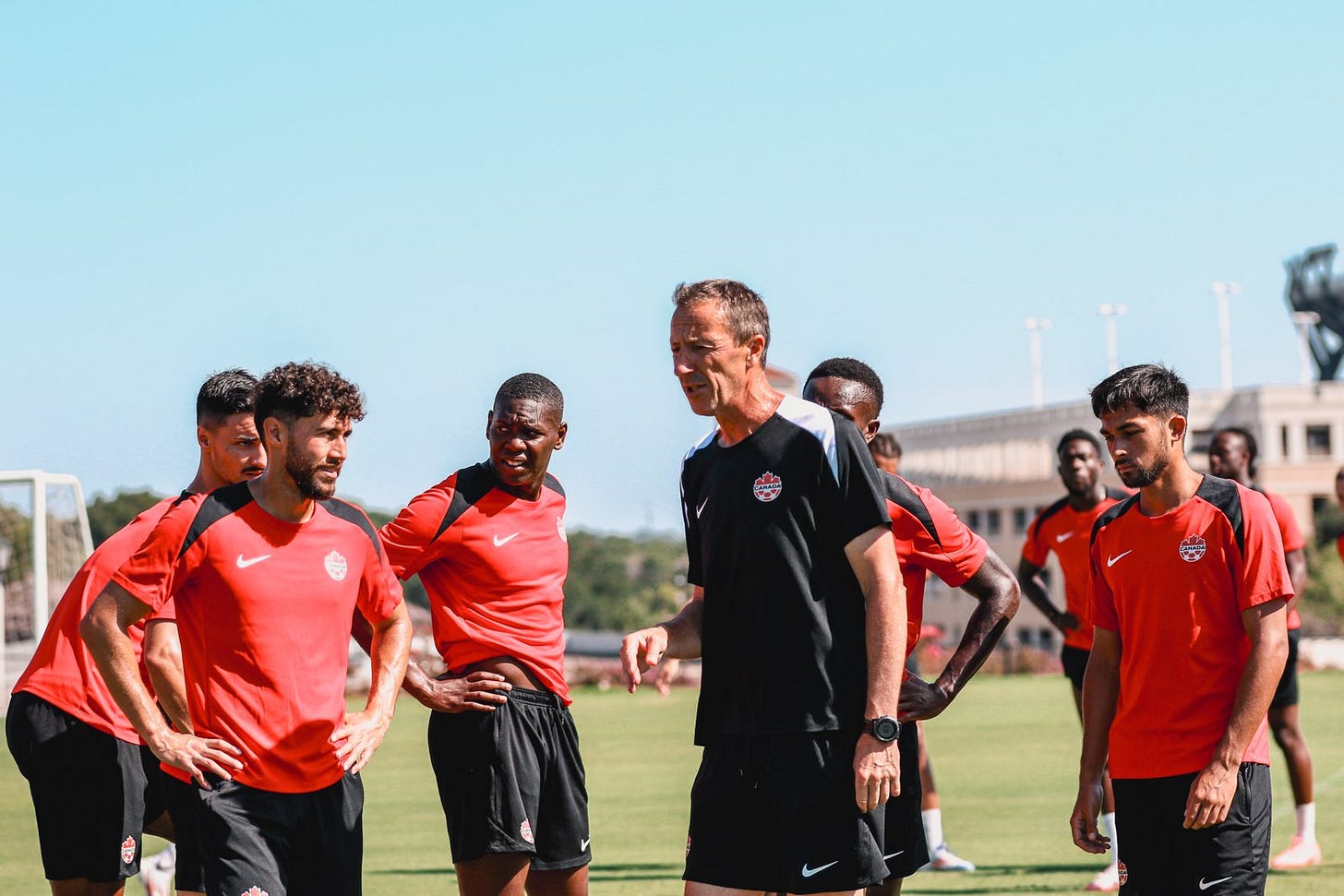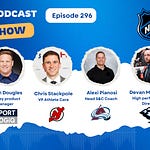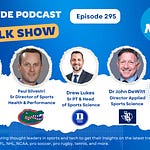Today we have the honor of interviewing Pierre Barrieu, the director of performance for the Canadian national men soccer team, and a technical advisor for the UEFA and also works as a freelancer for the FIFA.
Credits: Audrey Magny
Pierre Barrieu is a highly respected sports performance expert with extensive experience in elite soccer. Originally from France, he has worked with multiple national teams, including the U.S. Men's National Team (USMNT) across three FIFA World Cups (2002, 2006, and 2010) and the Canada Men's National Team. Barrieu has also held key performance roles at top clubs such as LA Galaxy, New York Red Bulls, and Le Havre AC, specializing in strength and conditioning, recovery, and high-performance strategies. Known for his expertise in sports science and data-driven training methodologies, he has been instrumental in optimizing player performance at both the national and club levels.
Credits: Audrey Magny
📝Show Notes: Through this interview, we touched on his background, and his role at Canadian national men soccer team. We also touched on what his typical day looks like. We also discussed his approach towards innovation, performance training and recovery, and how important technologies are to help better train his athletes and help them recover faster. We also touched on some of his favorite technologies and what he is looking for when him and his team are looking to adopt a new technologies. Drew also shared his thoughts on how he sees technologies impacting the Canadian national men soccer team from a performance training, and recovery perspective in the future. He also shared his thoughts on what makes the group within the Canadian men national soccer team special and what his expectations are for his team at the upcoming 2026 Soccer World Cup.
You can read the full transcript of the podcast interview with Pierre located at the top of this blog post.
Here are the quotes from the interview with Pierre:
Q1. Please tell me about your background and your role at the Canadian Men’s National Soccer Team.
"I started as an athlete, playing team handball and football at a high level in Europe. My interest in sports science led me to pursue a career in performance, but at the time, there wasn’t much infrastructure for that in Europe. That’s why I decided to take a break, move to the U.S., and explore what was being done there. I ended up at the University of Virginia, earning a Master’s in Athletic Training and working with their soccer team."
"From there, I joined U.S. Soccer and spent three World Cup cycles with the U.S. Men’s National Team. At that time, I was essentially a one-man band, responsible for building out the entire physical performance structure. After my time with the U.S., I worked for the UAE national team, creating a coaching school and establishing a fitness coaching license."
"I then transitioned into club football, which—unlike national team work—is much more unstable and dynamic. Over the years, I’ve worked in France, the Premier League, The Championship and MLS, including LA Galaxy, New York Red Bulls, and Toronto FC. Most recently, I was with Leeds United in the Premier League before taking on my role with Canada Soccer. My career has been evenly split between national teams and clubs, giving me a broad perspective on performance, player management, and the different approaches taken in each setting.”
Q2. What does your typical day look like at the Canadian Men’s National Soccer Team?
"My daily routine depends heavily on whether we are in camp or between camps. The two are completely different worlds. Between camps, a big part of my job is keeping in close contact with players, monitoring their performances, visiting clubs, and working with their performance staff. Every week, I watch every minute played by our squad, and we create detailed video clips for the coaching staff. We need to be on top of what our players are doing at all times, so when they come into camp, we already have a clear picture of their condition, workload, and playing rhythm."
"When we’re in camp, things shift dramatically. We essentially become a club team for two weeks, but without a permanent home base. Each FIFA window is a two-game cycle, so we have to be incredibly efficient with our time. The structure of our day is straightforward—wake up, breakfast, training, recovery, gym work, and multiple meetings. Meetings are more frequent than in club football because we have less time to prepare and a lot of tactical, physical, and logistical details to cover."
"One of the biggest differences between club and national team football is that, at the international level, we don’t spend much time on rehabilitation. Clubs handle long-term injuries, so if a player is injured, we simply don’t call them up. This means we don’t have the same extensive rehab structure that a club would have, though during major tournaments, that does become part of our responsibilities."
Q3. What is your approach towards innovation? How important are technologies in training and recovery?
"My philosophy on innovation is practical and simple. National teams are not an experimental lab. We don’t have the time to test new technologies or trial emerging methodologies. Everything we use has to be proven to work and must integrate seamlessly into our limited time with players."
"Because we don’t have the luxury of daily training like a club, I draw heavily from my experience in club football and my network of trusted professionals. If there’s an edge we can gain—whether in recovery, travel management, or performance monitoring—I try to implement it in a way that is non-disruptive to the players. The key is ensuring that we enhance what players are already doing at their clubs rather than interfering with their established routines."
"One thing I’ve learned is that forcing technology on players can be counterproductive. If an athlete doesn’t believe in a tool, it’s unlikely to be effective. That’s why I focus on education and buy-in, showing players how certain methods or technologies can benefit them. Some things I make mandatory, but for the most part, I want players to take ownership of their own performance and recovery."
Q4. What are some of your favorite technologies that you use at the Canadian Men’s National Soccer Team? Why?
"The reality is that, unlike a club, we don’t have a dedicated training facility. We are constantly traveling, setting up camp in different locations. That means any technology we use must be highly portable and easy to transport. If it’s too heavy or takes up too much space, it simply isn’t an option."
"One technology I like is KangaTech, which is great for isometric strength testing. We don’t have it yet, but it’s something I’d like to introduce. It’s portable and would be easy to implement in our setup."
"Other than that, we rely on the basics—GPS tracking, AMS systems, heart rate monitoring, and recovery tools like cold tubs. We have to be smart with our budget, and as we get closer to the World Cup, we’ll look at expanding our resources to match the demands of the tournament."
"One area I’d like to explore further is thermography. It’s something I looked into while at Leeds United, and I see potential in using it to monitor fatigue, injury risk, and recovery patterns. It could be a useful tool as we approach 2026. Personalized sleep strategies and tools could be another topic I’d like to explore"
Q5. When looking to adopt a new technology, what are the most important criteria?
"For me, a technology must solve a problem, not create one. It has to fit seamlessly into our workflow and save time rather than add complexity."
"Scientific backing is important, but I also rely on real-world validation. Some of the best technologies I’ve used didn’t have published studies at first, but I saw first-hand the impact they had at a club level. If I see something making a measurable difference in a high-performance environment, that’s enough for me to consider it."
"Size and weight are also major factors. For a traveling national team, portability is crucial. If something is too bulky, we simply won’t bring it, no matter how good it is."
Q6. What is special about this group of players? Why did you do so well in the last competition?
"This team has a strong identity and a lot of belief. One of the reasons Jesse Marsch was interested in taking the job was because he felt the players’ attributes aligned well with his high-intensity, high-tempo style of football. And the players have responded to that."
"Beyond tactics, this team has a unique togetherness. Many of these guys are genuine friends, and they love representing their country. That kind of chemistry is rare and has been a key factor in our performances."
"In a lot of ways, this reminds me of the U.S. team in 2001—a talented group that was hungry to prove itself on the world stage. This generation of Canadian players has that same sense of mission—to elevate soccer in Canada and show that they belong at the highest level."
Q7. How far do you think Canada can go in the 2026 World Cup?
"The goal is clear: get out of the group stage. Canada has never won a World Cup game before, so that’s our first step. After that, in a knockout tournament, anything is possible."
"The most important thing is making sure that, when teams see Canada in their group, they know they’re in for a fight. We want to be a team that no one wants to play against."
You may also like:
🔥Upside Chat with Drew Lukes (Duke University/NCAA), Jordan Troester (University of Oregon/NCAA), Pierre Barrieu (Canada Soccer)
This week we had the honor to interview again a group of sports performance experts.
🔥Upside Chat with Pierre Barrieu (Canada Soccer), Adam Quigley (MLS/NFL), Alexi Pianosi (Colorado Avalanche/NHL) on Concussions, ChatGPT, the Offseason, Mbappe, and More.
This week we had the honor to interview again a group of sports performance experts.















